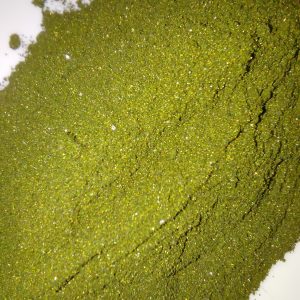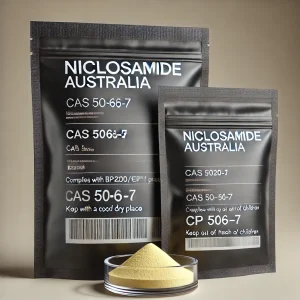🧬 The History of Niclosamide: From Anti-Parasitic Drug to Modern Scientific Marvel
- Few compounds have traveled such a fascinating journey in medicine as Niclosamide. Initially developed to fight parasitic infections, this humble molecule is now under the spotlight for its surprising versatility—showing promise against viruses, cancer, and even metabolic diseases. In this blog, we’ll dive deep into the history of Niclosamide, tracing its origins, early uses, and its evolution into a modern research powerhouse.

🧪 The Discovery of Niclosamide
The story of Niclosamide begins in the early 1950s when pharmaceutical scientists were in a global race to find effective treatments for parasitic infections, especially tapeworms. Tapeworm infestations were a major public health concern, particularly in regions with poor sanitation and limited access to modern healthcare.
Researchers at Bayer AG, a German pharmaceutical company, developed Niclosamide through a process of chemical screening aimed at creating compounds that could kill cestodes (tapeworms) without being toxic to humans. After extensive animal testing and early clinical trials, Niclosamide proved highly effective.
Key Facts about Early Niclosamide:
Year of Discovery: 1953–1958
Primary Use: Anti-cestodal (anti-tapeworm) agent
Chemical Class: Salicylanilides
Mode of Action: Disruption of mitochondrial oxidative phosphorylation, leading to energy depletion in parasites.
—
🌍 Global Adoption in the 1960s
By the early 1960s, Niclosamide was approved for human use in many countries and rapidly became the gold standard treatment for Taenia saginata (beef tapeworm), Taenia solium (pork tapeworm), and other cestode infections.
The drug was appreciated for its:
High efficacy
Low systemic absorption (stays mostly in the gut)
Minimal side effects
In 1977, the World Health Organization (WHO) included Niclosamide on its List of Essential Medicines, recognizing its importance in global health for controlling intestinal parasitic infections.
—
⚗️ Chemical Structure and Properties
Niclosamide’s chemical structure contributed to its effectiveness:
Chemical Formula: C₁₃H₈Cl₂N₂O₄
Solubility: Poorly soluble in water (a factor that limited its bioavailability beyond gastrointestinal applications)
Physical Form: Yellow crystalline powder
Its low absorption meant it was ideal for gut infections but less suited for systemic diseases—something researchers would revisit decades later.
—
🔬 Beyond Parasites: Repurposing Efforts Begin
1980s–1990s: Early Hints at Broader Uses
Scientific curiosity around Niclosamide’s biological effects led to early laboratory studies suggesting it could inhibit:
Tumor cell proliferation
Bacterial growth
Inflammation pathways
However, during this period, no major clinical breakthroughs occurred because the pharmaceutical industry was focused more on new drug development rather than drug repurposing.
—
2000s: New Era of Biomedical Research
In the early 2000s, the idea of drug repurposing gained popularity. Researchers realized that many “old” drugs might have untapped potential for modern diseases.
Niclosamide entered the spotlight again when studies revealed it could modulate key cellular pathways such as:
Wnt/β-catenin signaling (involved in cancer development)
mTORC1 pathway (central to metabolism and cell growth)
STAT3 pathway (important in cancer and immune responses)
Scientists began to seriously consider Niclosamide as a multi-target therapeutic agent.
—
🦠 The COVID-19 Pandemic: Niclosamide’s Viral Moment
In 2020, the COVID-19 pandemic triggered an urgent search for antiviral therapies. Niclosamide showed strong antiviral activity against SARS-CoV-2 in laboratory experiments.
Highlights:
It inhibited viral replication in human lung cells.
It disrupted viral entry by altering endosomal acidification.
It demonstrated effectiveness against other viruses like Zika, Dengue, and Influenza in earlier studies.
As a result, Niclosamide quickly entered multiple clinical trials worldwide as a candidate for COVID-19 treatment, including formulations like nasal sprays and inhalable powders to bypass its low oral bioavailability.
—
⚡ Current and Emerging Applications
Today, Niclosamide is being investigated for a wide range of diseases:
—
⚠️ Important Disclaimer
Pharmaceutical-grade Niclosamide is intended strictly for scientific research purposes only. It is not approved for human consumption outside of properly controlled clinical settings. Always follow professional and regulatory guidelines when handling or studying this compound.
—
🧠 Conclusion: From Tapeworms to Therapeutic Frontiers
Niclosamide’s journey—from a simple tapeworm killer to a modern-day research marvel—illustrates the incredible value of drug repurposing. As we continue to explore its full potential, this decades-old molecule may help address some of today’s most urgent health challenges.
Its story is far from over—in fact, it may just be beginning.
External Resources
📚 Suggested References (with links)
1. FDA Drug Label for Niclosamide
→ FDA Niclosamide Information
(Official approval and usage label.)
2. WHO List of Essential Medicines
→ World Health Organization – Essential Medicines List
(Niclosamide listed as an anthelmintic.)
3. PubMed Study – Niclosamide as Antiviral Agent
→ Niclosamide inhibits SARS-CoV-2 replication
(Published antiviral research during COVID-19 pandemic.)
4. Science Direct – Niclosamide repurposing for Cancer
→ Repurposing Niclosamide for Cancer Therapy
(Scientific review discussing anti-cancer applications.)
5. National Center for Biotechnology Information (NCBI) – Niclosamide Mechanisms
→ Mechanisms of Action for Niclosamide
(How it affects Wnt, mTOR, and other pathways.)
6. ClinicalTrials.gov – Niclosamide Trials for COVID-19
→ Ongoing Clinical Trials with Niclosamide
*(Search results showing multiple trials.)
7. Nature Communications – Broad-spectrum antiviral activity
→ Niclosamide’s Broad-Spectrum Antiviral Properties
*(Highly cited s
tudy during early COVID research.)
Products
-
 T
Rated 0 out of 5
T
Rated 0 out of 5$0.50Original price was: $0.50.$0.20Current price is: $0.20. -
 SALE!!! Pure Methylene Blue 50 Gram Powder
Rated 0 out of 5
SALE!!! Pure Methylene Blue 50 Gram Powder
Rated 0 out of 5$999.00Original price was: $999.00.$799.00Current price is: $799.00. -
 Niclosamide 20G Powder - Premium Pharmaceutical Grade
Rated 0 out of 5
Niclosamide 20G Powder - Premium Pharmaceutical Grade
Rated 0 out of 5$79.00Original price was: $79.00.$59.00Current price is: $59.00. -
 Niclosamide 100G Powder - Premium Pharmaceutical Grade
Rated 0 out of 5
Niclosamide 100G Powder - Premium Pharmaceutical Grade
Rated 0 out of 5$299.00Original price was: $299.00.$249.00Current price is: $249.00. -
 Niclosamide 50G Powder - Premium Pharmaceutical Grade
Rated 0 out of 5
Niclosamide 50G Powder - Premium Pharmaceutical Grade
Rated 0 out of 5$149.00Original price was: $149.00.$129.00Current price is: $129.00.
